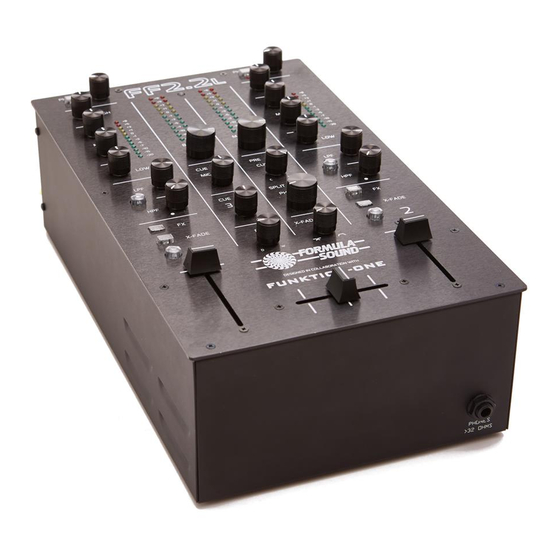Formula Sound FF2.2 User Manual - Page 6
Browse online or download pdf User Manual for DJ Equipment Formula Sound FF2.2. Formula Sound FF2.2 15 pages.

Each channel has a line and a phono input on separate RCA connects with a switch to select
the required input. The line input has a gain trim accessible through the back panel.
The phono inputs have a capacitance selector accessible through the base of the unit that
allows one of 4 capacitances values to be selected to best match the deck cartridge
capacitance. To select the correct capacitance value take the cartridge recommended value
(usually a range) and subtract the capacitance of the phono leads (typically 50pF – 100pF
depending on length) and choose the nearest setting.
Choosing the optimum capacitance setting for your cartridge on phono will make the sound
reproduced from vinyl slightly more accurate to what was recorded, conversely the wrong
setting will produce a slightly less accurate reproduction, the difference in settings is small.
Turntables can be susceptible to low frequency noise, this noise consists of two types, the
first is a very low frequency rumble and the second is up to 100Hz. The FF2.2 has a rumble
filter to deal with very low frequency noise and a noise cancelling circuit to deal with noise up
to 120Hz on the phono input.
The rumble filter is activated by a switch accessible through the back panel, the rumble filter
starts to remove signals below 14Hz and removes most signal below 7Hz.
The FF2.2 has a phono noise cancelling feature that utilises the 120Hz bass EQ band of the
mixer, just above the FF2.2 bass control is a hidden switch accessible through the front panel
that allows the bass to be summed to mono.
Noise picked up on the needle arm of the turntable appears as a difference signal on the
stereo left and right output, this noise is generally below 120Hz and by summing the Bass
stereo signal this left right difference noise cancels thus removing it.
Audio in stereo below 150Hz contributes little if anything to the stereo image and often these
frequencies in mono are considered an improvement, sub bass being mono illustrates this
point.
The user can decide if they wish to have the noise cancelling effect of summing the bass with
a mono bass below 120Hz and set the switch on or have the bass in stereo and no noise
cancelling.
We suggest the user tries playing vinyl with and without the rumble filter and noise cancelling
to decide which sounds better. Generally the effect of both these circuits is small, the rumble
filter should have no detrimental effect if used even if no positive effect is detectable (if there
is little or no rumble you cannot remove it), the noise cancelling will be more detectable
although also small and it may be that the perceived improvement is from the mono bass as
much as any noise cancelling.
Gain and level
The signal level on each channel is set by a GAIN control with a range of +/- 12dB and a
linear channel fader to control the level sent to the output.
5
